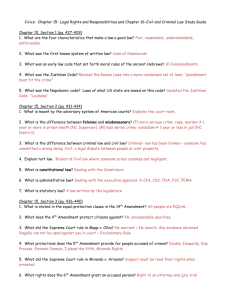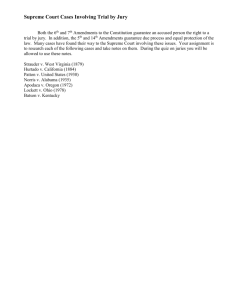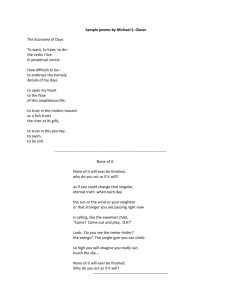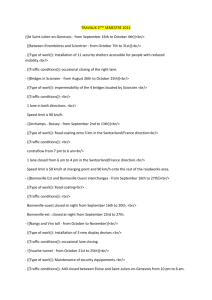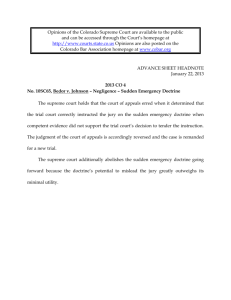Emergency Instruction - Oregon Casualty Adjusters Association
advertisement
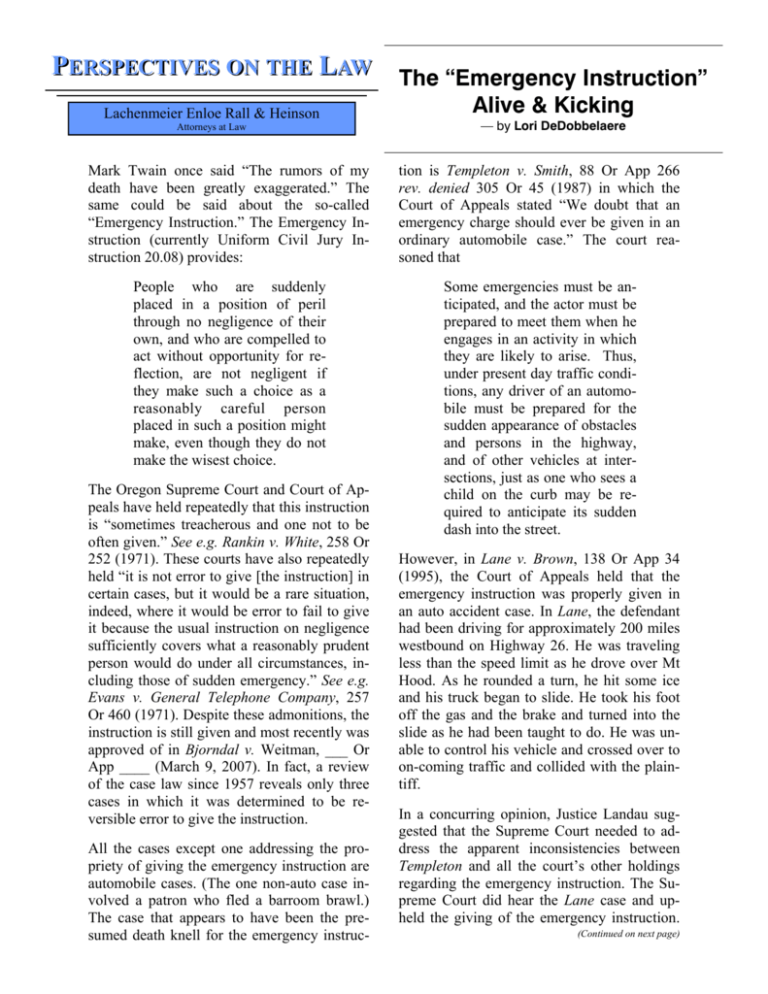
PERSPECTIVES ON THE LAW The “Emergency Instruction” Lachenmeier Enloe Rall & Heinson Attorneys at Law Alive & Kicking — by Lori DeDobbelaere Mark Twain once said “The rumors of my death have been greatly exaggerated.” The same could be said about the so-called “Emergency Instruction.” The Emergency Instruction (currently Uniform Civil Jury Instruction 20.08) provides: tion is Templeton v. Smith, 88 Or App 266 rev. denied 305 Or 45 (1987) in which the Court of Appeals stated “We doubt that an emergency charge should ever be given in an ordinary automobile case.” The court reasoned that People who are suddenly placed in a position of peril through no negligence of their own, and who are compelled to act without opportunity for reflection, are not negligent if they make such a choice as a reasonably careful person placed in such a position might make, even though they do not make the wisest choice. Some emergencies must be anticipated, and the actor must be prepared to meet them when he engages in an activity in which they are likely to arise. Thus, under present day traffic conditions, any driver of an automobile must be prepared for the sudden appearance of obstacles and persons in the highway, and of other vehicles at intersections, just as one who sees a child on the curb may be required to anticipate its sudden dash into the street. The Oregon Supreme Court and Court of Appeals have held repeatedly that this instruction is “sometimes treacherous and one not to be often given.” See e.g. Rankin v. White, 258 Or 252 (1971). These courts have also repeatedly held “it is not error to give [the instruction] in certain cases, but it would be a rare situation, indeed, where it would be error to fail to give it because the usual instruction on negligence sufficiently covers what a reasonably prudent person would do under all circumstances, including those of sudden emergency.” See e.g. Evans v. General Telephone Company, 257 Or 460 (1971). Despite these admonitions, the instruction is still given and most recently was approved of in Bjorndal v. Weitman, ___ Or App ____ (March 9, 2007). In fact, a review of the case law since 1957 reveals only three cases in which it was determined to be reversible error to give the instruction. All the cases except one addressing the propriety of giving the emergency instruction are automobile cases. (The one non-auto case involved a patron who fled a barroom brawl.) The case that appears to have been the presumed death knell for the emergency instruc- However, in Lane v. Brown, 138 Or App 34 (1995), the Court of Appeals held that the emergency instruction was properly given in an auto accident case. In Lane, the defendant had been driving for approximately 200 miles westbound on Highway 26. He was traveling less than the speed limit as he drove over Mt Hood. As he rounded a turn, he hit some ice and his truck began to slide. He took his foot off the gas and the brake and turned into the slide as he had been taught to do. He was unable to control his vehicle and crossed over to on-coming traffic and collided with the plaintiff. In a concurring opinion, Justice Landau suggested that the Supreme Court needed to address the apparent inconsistencies between Templeton and all the court’s other holdings regarding the emergency instruction. The Supreme Court did hear the Lane case and upheld the giving of the emergency instruction. (Continued on next page) —2— Lane v. Brown, 328 Or 42 (1998). However, in doing so, it did not address any of Justice Landau’s concerns. So it would appear that the instruction lives on. It is, therefore, important to understand when it would be appropriate to ask for the emergency instruction. In order for the instruction to be proper in any given case, several criteria must first be met. First, there must be an emergency. Whether there is an emergency is a question of fact for the jury. Harkins v. Doyle, 271 Or 664 (1975). In Scott v. Iverson 120 Or App 538 (1993), the instruction was held to be inappropriate because defendant had not encountered an emergency. Defendant was driving down the road when she felt a thump which later turned out to be the bicyclist she hit. The court held that because the defendant had not seen the bicyclist before the accident, she could not have faced a true emergency and therefore the giving of the emergency instruction was improper. What constitutes an emergency? An emergency requires a person to be faced with a sudden danger, Lane v. Brown 138 Or App 34 (1995), and the need to exercise quick judgment as to which course to follow. See Ballard v. Rickbaugh Orchards Inc, 259 Or 200 (1971). Some examples from the cases are a sudden and unanticipated mechanical failure, a car suddenly appearing in front of the driver, the sudden need to flee a bar fight, coming upon a truck stopped in the road with no warning flares out, or coming upon unexpected road conditions. In Templeton, the court seemed to hold that the emergency must be an “extraordinary” one before it would be proper to give the instruction. However, in Lane, the plaintiff argued that the emergency encountered in that case was not an “extraordinary” one. The Oregon Supreme Court basically punted on that issue and merely restated that “whether there is an emergency in a particular case is a question of fact for the jury.” Lane 328 Or 42 at 47. Accordingly, it is not clear whether the emer- gency must be “extraordinary” but a good argument could be made based upon the holding in Lane that just a garden variety emergency will suffice. The second criteria is that the emergency condition can not have been caused by the negligence of the person requesting the instruction. This is fairly self-explanatory. The courts have left this determination up to the jury. For example, in Lane, plaintiff argued that the defendant was negligent in causing the “emergency situation.” The court held that “the fact that the evidence might support a finding that defendant’s negligence contributed to his peril does not mean that it was error to give the emergency instruction.” It appears that if you can show a true emergency existed then it becomes a question for the jury as to whether defendant’s own negligence contributed to the existence of the emergency. The third criteria is that the person requesting the instruction must have been “compelled to act without opportunity for reflection.” This is tied to whether the event was truly an emergency. If a driver has time to reflect then there would be no need for “quick judgment.” If you satisfy all three of the above criteria then it would be proper to give the jury the emergency instruction. However, it may be very difficult to get a court to agree with you. My experience with trial judges tells me that most of them will take the safe route. That is, if one party asks for the instruction and the other party objects, the judge will not give the instruction. The judge runs little risk of being overturned on his/her refusal to give the instruction since the Supreme Court has held that “it would be a rare situation, indeed, where it would be error to fail to give” the instruction. Accordingly, although the instruction is alive and kicking, it may be difficult to get a court to agree to use it. — Please direct any questions in this area of law to the author, Lori DeDobbelaere, at 503-768-9600, or by email to lori@lerlaw.com.

